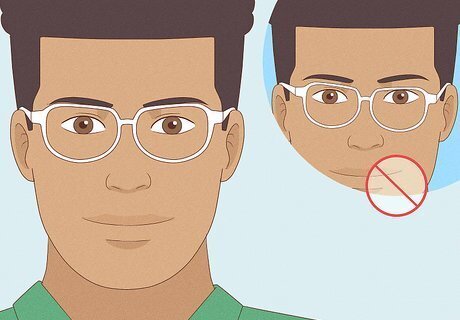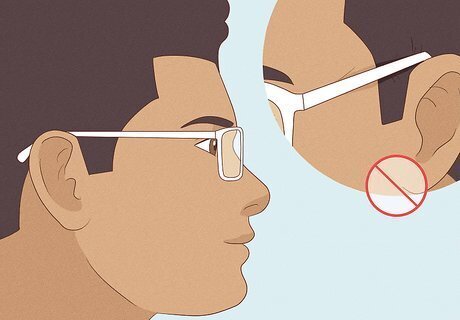
views
- Fit your glasses so your pupils line up with the centers of the lenses so you can see clearly. You should still see your eyebrows above the frame.
- Position your glasses on the bridge of your nose so they don't pinch or slide down. If you feel any discomfort, the frames may be too small.
- Check that your glasses hug your head tightly just above your ears without causing any pain.
- Take measurements of an old pair of glasses or your face to find the lens width, bridge size, and arm length you need.
Measuring Frame Size
Check the measurements on a pair of glasses that fit you well. If you already own a comfortable pair of glasses, look for the measurements in millimeters by finding the 3 numbers on the inside of the temple arm or the bridge of the nose. The first number represents the width of 1 lens, the second number is the width of your nose bridge, and the last number is the length of the glasses arm, also known as the “temple length.” Jot these numbers down so you can remember them when you’re getting your next pair of glasses. If there’s a fourth number listed, then it represents the lens height at its tallest point.
Find your bridge size based on if it’s higher or lower than your pupils. Take a selfie of the side of your face so you can see where your nose bridge lines up with your pupils. If your bridge is level or lower than your pupils, use a low bridge size between 16–18 millimeters. If your bridge is above your pupils, then go for a bridge size around 19–21 millimeters instead. You can use a glasses ruler that’s specifically used to measure your eyes for a more accurate home measurement. If you want to measure an old pair of glasses, find the width between the lenses at their narrowest point. Bridge sizes that are too narrow could pinch the sides of your nose, but too wide of a bridge could make your glasses slide off your face.
Measure your face from temple to temple to find the frame width. Stand in a mirror and look straight ahead. Hold a ruler level with your temples and find the distance in millimeters. When you look at glasses, try to find ones that have a frame width within about 2–3 millimeters of your measurement to ensure they fit properly. If your frames are too wide, then it could make your face look imbalanced. If your frames are too narrow, your glasses may feel too tight and get uncomfortable pretty quickly. To get a rough estimate of the lens width for your glasses, subtract your bridge size from the frame width. Then, divide that number by 2. For example, if your frame width is 125 mm and your bridge size is 18 mm, then 125 m m − 18 m m = 107 m m {\displaystyle 125mm-18mm=107mm} {\displaystyle 125mm-18mm=107mm}. Then, 107 m m / 2 = 53.5 m m {\displaystyle 107mm/2=53.5mm} {\displaystyle 107mm/2=53.5mm} for the lens width.
Choose temple arm lengths around 140 mm. Temple arms usually run from 130–145 mm for adults and 120–140 mm for children. Since 140 mm is the average temple arm length for an adult, it’s usually a safe bet for your measurements, and you can always make minor adjustments once you get them to make them more comfortable. To measure the temple arms on an old pair of glasses, find the distance from the hinge to the tip of the arm. There’s not really an easy way to measure your face to determine the temple arm length. Try a few pairs of glasses on and check their sizes to see what feels best for you.
Find your pupillary distance. Your pupillary distance (PD) is the measurement from the center of one pupil to the other. Stand about 8 inches (20 cm) away from a mirror and hold a ruler against your brow. Close your right eye and align the end of the ruler with the center of your left pupil. Look straight ahead as you close your left eye and open your right eye. Check where the ruler lines up in the center of your right pupil to take your measurement in millimeters. Ask a friend to help you to take a more accurate measurement. Try using an app like GlassesOn or EyeMeasure to help you measure your PD based on a photo. Some online glasses retailers like Warby Parker have online tools to take measurements for you. If you don’t want to measure your pupillary distance yourself, check if the measurement is listed on an old prescription you have. If you can’t find it, then make an appointment with your optometrist.
Fitting Glasses to Your Features

Set your glasses on your nose so they don’t pinch or slide down. Position your glasses against the bridge of your nose and check if they feel comfortable. If the glasses have a proper fit, the weight of the frame will distribute evenly and you won’t feel any pressure on the sides of your nose. If the bridge is too wide, then the glasses will slide down your nose and you’ll have to keep readjusting them. If your glasses leave red marks on your nose, then it’s a sign that your frames are too tight. Adjust the nose pads if you can so they have a looser fit. If your glasses don’t have nose pads, stick on adhesive pads under the bridge to help them fit better.
Position the lenses so your eyes are in the center. Stand in front of a mirror and put on a pair of glasses. Since the clearest parts of your prescription are in the centers of the lenses, ensure that’s the part you’re looking through. If your pupils aren't centered in the lenses, then they could cause eye strain. For bifocals, the line on the lens should line up with the highest point on your bottom eyelid.
Keep the top of the frame below your eyebrows. If your frames cover or extend past your eyebrows, then it could make it look like you’re missing eyebrows completely. Choose frames that are thin enough to fit in the space between your eyes and your eyebrows rather than thick, chunky styles. If your eyebrows are close to your eyes, then also avoid half-frame glasses since they make your face feel a little imbalanced.
Fit your glasses so they sit above your cheeks. Put your glasses on and smile really big. If you feel your cheeks touching your frames, then they’re too small or too far down your nose. With a proper fit, you won’t ever feel your glasses against your cheeks no matter how expressive you’re being.

Position the temple arms so they feel snug above your ears. Put on your glasses and move your head around in a circle. Your frames should hug the sides of your head just above your ears comfortably without moving around. If you feel any pressure on the sides of your head, then your glasses are too tight. If your glasses feel loose or slide off your face, then the arms are too long or the frames are too big for you. You can try using a glasses strap to hold your glasses tighter.
Choose a frame style that compliments your face shape. Figure out the shape of your face so you can get frames that really accentuate your features. While some frames will look really good on certain face shapes, they might make other faces look imbalanced. If you have an oval face, try square or rectangular frames. For a round face, try oversized rectangular or square frames. For a square-shaped face, try rounded or cat-eye frames. If you have a narrow face, then try to get glasses that are a little wider to help balance out your face.














Comments
0 comment